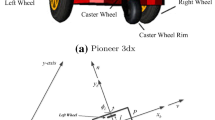Abstract
Conventional fuzzy controllers for motion tracking utilize generally two input variables (position error and velocity error) to deal with highly nonlinear and time-varying dynamics associated with complex mechanical motion with multi- DOF. This results in some tracking errors at steady state, in general, mainly due to friction existing in mechanical systems. To eliminate the steady-state tracking errors, a variable structure fuzzy control algorithm is proposed using three input variables (position error, velocity error, and integral of position errors) and a switching logic between two inputs and three inputs. Simulation and experimental studies have been conducted to show the validity of the proposed control logic using a direct-drive SCARA manipulator with two degree-of-freedom. It has been shown that the proposed fuzzy control logic has significantly improved motion-tracking performance of the mechanical system when it is applied to complex polygon-tracking in Cartesian space with inverse kinematics and path planning.
Similar content being viewed by others
References
F. L. Lewis, C. T. Abdallah and D. M. Dawson, Control of robot manipulators, Macmillan Publishing Co., (1993).
S. Kohn-Rich and H. Flashner, Robust fuzzy logic control of mechanical systems, Fuzzy Sets and Systems, 133 (2003) 77–108.
C. Ham, Z. Qu and R. Johnson, Robust fuzzy control for robot manipulators, IEE Proc. Control Theory and Applications, 147(2) (2000) 212–216.
M. K. Park, M. C. Lee and W. S. Yoo, Sliding mode control with fuzzy adaptive perturbation compensator for 6-DOF parallel manipulator, KSME International Journal, 18(4) (2004) 535–549.
L. A. Zadeh, Fuzzy sets, Informat. Control, 8 (1965) 338–353.
L. A. Zadeh, Outline of a new approach to the analysis of complex systems and decision processes, IEEE Trans. Syst. Man Cybern., 3 (1973) 28–44.
E. H. Mamdani, Application of fuzzy algorithms for simple dynamic plant, Proc. IEE, 121 (1974) 1585–1588.
J. Maiers and Y. S. Sherif, Applications of fuzzy set theory, IEEE Trans. Syst. Man Cybern., 15 (1985) 175–189.
M. Sugeno, An introductory survey of fuzzy control, Infor. Sci., 36 (1985) 59–83.
R. M. Tong, A control engineering review of fuzzy systems, Automatica, 13 (1977) 559–569.
C. C. Lee, Fuzzy logic in control systems: Fuzzy logic controller-Part I, II, IEEE Trans. Syst. Man Cybern., 20 (1990) 404–435.
L.-X. Wang, Adaptive fuzzy systems and control: Design and stability analysis, Prentice-Hall, (1994).
Y. F. Li and C. C. Lau, Development of fuzzy algorithms for servo systems, IEEE Control Systems Magazine, (April 1989) 65–72.
L.-J. Huang and M. Tomizuka, A self-paced fuzzy tracking controller for two-dimensional motion control, IEEE Trans. Syst. Man Cybern., 20 (1990) 1115–1124.
E. M. Scharf and N. J. Mandic, The application of a fuzzy controller to the control of a multi-degree-of-freedom robot arm, in M. Sugeno, (Ed.): Industrial Applications of Fuzzy Control, Elsevier Science Publishers B.V., North-Holland, 41–62, (1985).
C.-G. Kang and H.-S. Kwak, Fuzzy logic control for direct drive robot manipulator, Proc. Korean Automatic Control Conference, International 1 (1994) 428–433.
J. M. Adams and K. S. Rattan, Genetic multi-stage fuzzy PID controller with a fuzzy switch, Proc. IEEE Syst. Man Cybern. Conf., 2239–2244, (2001).
P. Sooraksa, T. Pattaradej and G. Chen, Design and implementation of fuzzy P2ID controller for handlebar control of a bicycle robot, Integrated Computer-Aided Engineering, 9 (2002) 319–331.
C.-G. Kang and H.-S. Kwak, A Fuzzy control algorithm reducing steady-state position errors of robotic manipulators, Proc. 4th Intern. Workshop on Advanced Motion Control, 121–126, (1996).
C.-G. Kang and H.-S. Kwak, Fuzzy control algorithm eliminating steady-state position errors of robotic manipulators, Trans. Korean Society of Mechanical Engineers, 21(3) (1997) 362–368. (In Korean)
W. Pedrycz, Fuzzy control and fuzzy systems, 2nd edition, John Wiley & Sons, (1993).
J. Aracil and F. Gordillo, Describing function method for stability analysis of PD and PI fuzzy controllers, Fuzzy Sets and Systems, 143 (2004) 233–249.
C.-G. Kang, R. Horowitz and G. Leitmann, Tracking control of robot manipulators using a robust deterministic control law, J. of Dynamic Systems, Measurement and Control, 120 (1998) 537–540.
M. W. Spong, S. Hutchinson and M. Vidyasagar, Robot modeling and control, John Wiley & Sons, (2006).
Author information
Authors and Affiliations
Corresponding author
Additional information
This paper was recommended for publication in revised form by Associate Editor Kyongsu Yi
Chul-Goo Kang received his B.S. and M.S. degree in Mechanical Design and Production Engineering from Seoul National University, Korea, in 1981 and 1985, respectively. He then received his Ph.D. degree from Univ. of California, Berkeley in 1989. Dr. Kang is currently a Professor at the Department of Mechanical Engineering, Konkuk University in Seoul, Korea. He serves as a board member of the Institute of Control, Robotics and Systems, and also Korea Robotics Society. His research interests include motion and force control, train brakes, and intelligent robots.
Rights and permissions
About this article
Cite this article
Kang, CG. Variable structure fuzzy control using three input variables for reducing motion tracking errors. J Mech Sci Technol 23, 1354–1364 (2009). https://doi.org/10.1007/s12206-009-0350-3
Received:
Revised:
Accepted:
Published:
Issue Date:
DOI: https://doi.org/10.1007/s12206-009-0350-3




